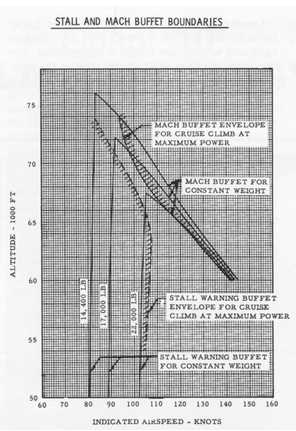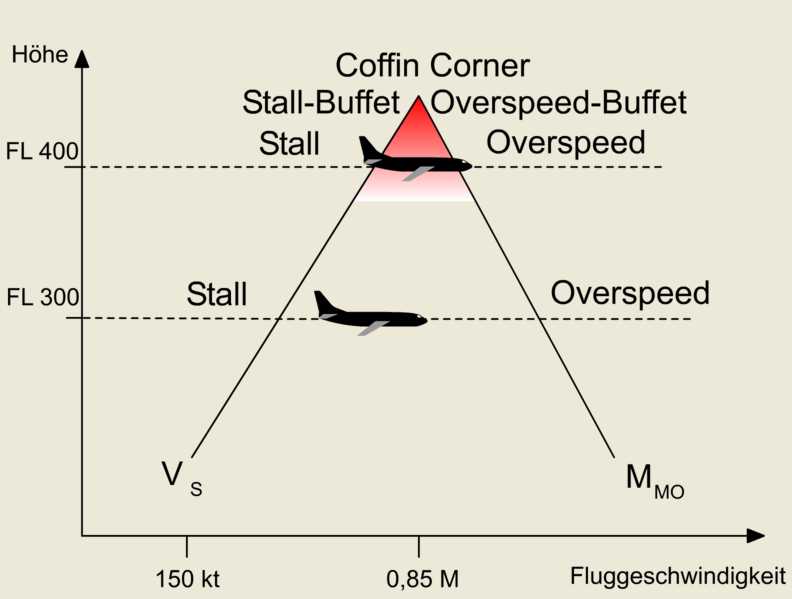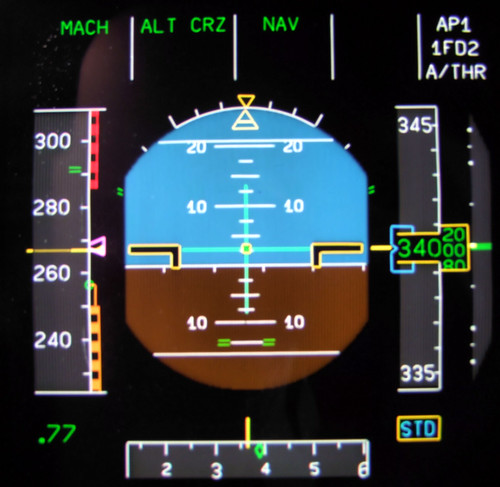| |
 
|
If crash investigators would
like to see what sort of history AF (and other airlines') pilots
have in respect of operating proximity to coffin corner, all
they'd have to do is review historic FDM/FOQA data. That should
make it clear whether or not there was any generic (or in the
case of the AF447 captain) specific proclivity for "riding the
tiger" in any misguided attempt to achieve greater economies. |
|
Air France flight AF 447 has gone missing over the Atlantic. The
flight left Rio at 2200 GMT on Sunday, and was due to land at 0910 GMT
in Paris, but contact was lost at 0130 GMT, some 186 miles northeast of
the Brazilian city of Natal. It had 216 passengers and 12 crew on board,
including three pilots. The passengers included one infant, seven chi...
|
| |
During harsh economic times, when jobs are at risk, it's understandable
that pilots are going to kick in and assist by making operations more
economical. The best way for long-haul pilots to do that is to fly right
up there in coffin corner despite their heavy weights, i.e. where the
margin between the aerodynamic stall and mach buffet is minimal (or even
negligible). That gives best engine and airframe fuel economy (air
nautical miles per pound) however it's also an exercise in stroking the
razor's edge. Do that above the 55,000 foot tops of the ITCZ
(Inter-Tropic Convergence Zone) and your environment-related
controllability hazards become very real. Even at night, you can fly
around the intense cells visually (or by radar) dodging the CB tops;
however it's also possible to strike Clear Air Turbulence associated
with the ITCZ..... or to stumble into a CB thunderhead that you didn't
see ahead (courtesy of its electrical activity and sheet lightning
flashes).
If that happens, what's next? Well...in fact you don't even need to
bumble into a thunderstorm's tops in order to come unstuck. All you need
is some turbulence or a sudden unexpected air temperature change
(affecting both airspeed and thrust output) - or an engine surge. Quite
simply it becomes a sudden loss of control on a dark night..... and only
a few thousand feet below you are the solid unfriendly cloud tops of the
ITCZ's solid thunderstorm activity. Once inside that maelstrom of cloud
below, with its severe turbulence, hail, lightning and electrical
activity, a successful recovery from an unusual attitude would be
unlikely. At this point you must recall that a FBW Airbus is limited in
its manoeuvrability by its control laws. That feature is designed to
stop pilots creating situations - however equally it can limit their
ability to recover from out-of-control "unusual attitudes" (e.g.
inverted or spinning). Control Laws cannot stop cataclysmic overstress
however.
A non-Airbus airliner may be able to recover from an upset that an
Airbus cannot (due to the limits of its control laws).
What about the ACARS auto-transmitted message of a serious electrical
failure? Well if the aircraft was being overstressed and breaking up,
you'd only need a few seconds for the generated faults to
self-precipitate a safety message to the Company OPS Centre via ACARS.
Unfortunately, unless you have a data-dump capability (remember my
Iridian/Roadshow
proposal?) you don't know what led up to that message (and as for what
came after? ...well, without
Iridian/Roadshow, you
have to recover the DFDR, QAR and CVR) for laboratory analysis.
So is Air France (and
obviously, other airlines) allowing (or directing) their crews to
get high early and start stroking that razor's edge whilst still at
high All-Up-Weight and very vulnerable? Is the Airbus FBW design
more vulnerable than others? Do crews practice tangles with coffin
corner in the simulator?
Daresay all that will
come out of the investigation. I somehow suspect that it will prove
to be the case. i.e. Crews have been over-extending their necks, bt
withy the vry best of intentions (protecting their jobs?).
Previous
examples of Coffin Corner Encounters?
|
| |
This Mach/ASI shows a margin of 35 knots; what margin would one normally
expect to have for a safe cruise in a high and heavy aircraft?
"what margin?" A minimum of at least twice any observed (or
anticipated) indicated airspeed fluctuations. Marrying the needles
is never a good idea because all it takes to "hit the wall" and
strike instant controllability issues is a sudden along-track
temperature rise, convective or clear air turbulence, a TCAS RA
event or an engine hiccup. Engines operating at coffin corner type
heights and speeds are running quite close to the edge of their
performance envelopes also (their design surge line) - because of
the reduced air density and mass through-flow. Turbulence can
momentarily disrupt intake flows and of course any sudden yaw
induced by one engine momentarily surging can also blank the other
engine's intake, precipitating a dual engine stall. That's what
happened in the Oct 04 Jefferson City crash of the Pinnacle Airlines
CRJ200 (link).
Pilots should (and
generally do) observe the weight versus height and ambient
temperature guide-lines available to them as both tables and graphs
in their aircraft operating manuals. However those numbers don't
factor in such wild-card variables as crossing the ITCZ. The
vertical instability in the atmosphere in the vicinity of that Zone
is well known to long-haul pilots. But, over the space of a
year, the ITCZ moves longitudinally North and south of the Equator.
It also varies in intensity with the seasons. In some months and
particularly on some days, like a volcano, it's much more
active..... and dangerous (see attached treatment of that subject).
Some bravado may be
evident where the pilots vow to "keep a close eye" on their coffin
corner exposure, but then fail to do so adequately. It's just
another form of conscious risk-taking and risk buffer erosion. It's
very similar to (say) conducting a short-field STOL approach to (for
instance) London City Airport. That's a very short duration risk
exposure and so both pilots are very much on the qui vive and ready
to react if things start looking border-line on finals. Coffin
corner exposures (by contrast) tend to be a very long-term
risk-taking venture and it would be very easy for fatigued crews to
let their guard down (or relief crews taking over to just not
realise how close to "the edge" they were operating).
I've no doubt that many
"insiders" are already aware of this likely scenario but quite
unwilling to even bring it up - beyond referring vaguely to
turbulence and lightning etc. I'd expect that the well-known French
reluctance to associate any incident or accident to the Airbus
control laws will continue to mask this probable scenario. Because
it is just a tangible threat it was always going to claim
someone/sometime. It's as likely a scenario as any other that's out
there at the moment. Recovery of the recorders should easily prove
(or disprove) this loss of control scenario. Prior to that
happening, I'd expect other AF and long-haul pilots enerally to
simply "keep their own counsel" on the subject. But they'd also have
quietly learnt from it.
Another
thought.
If
crash investigators would like to see what sort of history AF (and
other airline's) pilots have in respect of operating proximity to
coffin corner, all they'd have to do is review historic FDM/FOQA
data. That should make it clear whether or not there was any generic
(or in the case of the AF447 captain) specific proclivity for
"riding the tiger" in any misguided attempt to achieve greater
economies.
|
| |
This A330 was 3 hrs into
a flight fuelled for an 11hr trip, and level at FL350, with 228 POB. What
was the likely weight and what would be the low-end buffet
boundaries for that weight? What max turbulent air penetration
speed should they've been observing? What was the ISA deviation at
FL350 in that area that night? Was it ISA+10? ISA+15? (i.e. warm
air?). Lots of questions that should eventually be answered.
Hitting Mach buffet alone (in an intentional "Mach Run" for
instance) can create "tuck" problems. In the old Vampire you could
roll inverted at
|
Met synopsis
Tim Vasquez's report, whilst being fairly technical,
concludes well. We don't at the moment know the ADD
status of AF447 and what if any MEL's the a/c dispatched
under. So called ETOP's dispatch with single radar, IRS
fault or a prim/sec problem is feasible. Comment was
made that many crews frequently attempt to fly over
weather; but in an almost max weighted 330 or even 340,
this would be folly. Pilots who have little experience
of other types may attempt this manoeuvre but for those
with L1011/747 classic/DC10 time, that would be a rare
judgement call. The digi radar on the A330-200 requires
more analysis and very careful gain and tilt management
than earlier analogue types. The buffet thresholds at
close to or even at, max recommended (or above optimum)
altitude levels are also narrower than non FBW types.
For these reasons, lateral wx deviation, even by track
displacements of over 100nm are not uncommon within the
ITCZ that I operate through. It appears through Tim's
track analysis of Flt447, that no significant wx
avoidance was applied. As an afterthought, wrt CRM and
crew rest issues, were the senior crew resting at the
time of the 'event'? What was the crew pilot
complement/experience level? Was this a training sector
for either the Capt or F/O?
As a senior check and trainer on the 330 and 340, I
always, without exception employ two cardinal rules.
. Rough air speed protocols versus altitude limitations
must be applied early on in the piece. If the air is
rough, (med/light, med turb and above), select M.78
without delay. "Chunking down" of mach to finally
achieve target .78 is not recommended.
. Early wx deviation and crew lockdown is key to
successful wx damage avoidance. Never attempt to
out-climb weather. Cherry picking the weaker cells
and risking penetration of invisible gust regions, again
is total folly. Keep the big picture in mind, take the
additional fuel at flight planning and large track mile
deviations.
The above is intended to complement Tim's fine piece and
in no way wishes to undermine the severity of the event
and its tragic outcome.
|
40,000 feet so that the M0.84 pitch-up was actually a pitch-down
(towards terra firma). That ensured a continued rapid (violently
pitching) height loss but eventually you'd lose Mach No in the
thicker air lower down and the compressibility effects would just
evaporate - after quite a wild ride, but with no hazardous portents.
Hitting both Mach buffet and the aerodynamic stall at the same time
in the cruise (by marrying the needles) can give you the worst of
both worlds. Autopilot will disconnect (if not already done so by
the pilot) and the aircraft is likely to roll and pitch violently.
This could be complicated by an already stalled engine or the
yaw/high AoA is likely to induce an engine stall/loss of thrust -
introducing asymmetry and compounding the loss of control challenge.
As I've said before, the Airbus control laws are designed to stop
the pilot from putting himself in harm's way, however nothing in
those arcane control laws can stop an aircraft adopting weird and
unusual attitudes during a coffin corner encounter. And there's the
rub. Will the Airbus control laws help or hinder in such a scenario?
You can guess my suspicions on that score.
You have to use some imagination when trying to envisage the
combinational mach buffet and stall effects on the aircraft during a
cruise encounter. When a wing stalls there's an airflow breakdown
over the wing's upper surface - and that alone will cause the
compressibility pressure wave to move rapidly and violently
fore/aft. Both phenomena will change the fore-aft position of the
centre of pressure, initially causing wild pitch gyrations.
Inevitably any yaw component or mismatch between the wings will
generate a rapidly divergent (dutch?) yaw/roll/pitch cycle. If the
nose drops below the horizon then mach tuck (pitch "up" into the
turn = re-stall) is a likely outcome.
The ultimate conundrum lies in the 50% chance that a pilot caught by surprise (or disorientated or suffering
sudden vertigo)
will attempt a jet upset recovery by rolling the wrong way - i.e.
long way round.... (or perhaps an Airbus control law will limit his
choice to one way - possibly the wrong way). He may even be opposed
by his copilot attempting his own version of "recovery". What will
rolling the wrong way do? Modern jets are so clean that even if the
pilot got the power off, an aircraft entering an extreme nose-low
attitude will quickly accelerate to very high speeds (>Vne) and the
ensuing pull-out is likely to overstress (component shedding, hull
rupture, loss of pressurization, zoom back up into hypoxia country?
= pilot incapacitation) . Who knows. Always better to not go there.
Exceed the limits and you're in test-pilot country - in fact,
invading areas that you couldn't pay an experimental test pilot
enough to go. Coffin Corner is well named and best avoided by
sensible margins. I'm guessing that those margins will soon be
re-defined. The accident A330, if it reverted to direct law, would
lose most (all?) of its control law protections and thus be liable
to be easily "broken" by a pilot pulling hard - but with nil
experience in flying a BUS in Direct Law.
It's not definite that this was the AF447 scenario - but it's a top
contender. I'd suggest to the investigators that they closely review
the crash captain's (and other captains') FDM/FOQA records for their
style of operations on that route (or any other equatorial transits
across the ITCZ). That might be revelational. If long-haul pilots
are getting high early at higher weights, then they'd be doing it
for a reason. Flight plans don't count. It's what you decide to do
as you burn off your gas that decides how close you're operating to
your airplane's limits. Riding those limits at a low level of
personal awareness is to whimsically stroke the razor's edge.
John S
| An EXEMPLAR
Coffin Corner Accident |
| Date: |
22 AUG 2006 |
| Time: |
15:39 |
| Type: |
Tupolev 154M |
| Operator: |
Pulkovo Aviation Enterprise |
| Registration: |
RA-85185 |
| C/n / msn: |
91A-894 |
| First flight: |
1991 |
| Total airframe hrs: |
24215 |
| Engines: |
3 Soloviev D-30KU-154-II |
| Crew: |
Fatalities: 10 / Occupants: 10 |
| Passengers: |
Fatalities: 160 / Occupants: 160 |
| Total: |
Fatalities: 170 / Occupants: 170
|
| Airplane damage: |
Destroyed |
| Airplane fate: |
Written off (damaged beyond repair) |
| Location: |
45 km (28.1 mls) NW of Donetsk (Ukraine)
 |
| Phase: |
En route (ENR) |
| Nature: |
Domestic Scheduled Passenger |
| Departure airport: |
Anapa Airport (AAQ/URKA), Russia |
| Destination airport: |
Saint Petersburg-Pulkovo Airport (LED/ULLI),
Russia |
| Flightnumber: |
612 |
Narrative:
Pulkovo flight 612 departed Anapa (AAQ)
for St. Petersburg (LED) at 15:05. The Tupolev climbed to
the cruise altitude of 35,100 feet (10.700 m).
Because of storm
cells ahead, the pilot decided to change course laterally by
20 km and attempted to climb over the
storm cells. However, the thunderstorm front was
unusually high, extending up to 15 km (49,000 feet). The
Tu-154 entered an area of severe turbulence, pushing up the
airplane from 11.961 m to 12.794 m within just 10 seconds.
The angle of attack increased to 46 degrees and the airspeed
dropped to zero. It entered a deep stall from which the crew
could not recover. The plane crashed and burned in a
field.
Sources:
» 'Climb over storm' doomed Tu-154 (Flight 05/09/06)
» RIA Novosti
from:
http://tinyurl.com/q6vk7z |
|





